
Dr Kathryn Allen
Questions answered by this expert
This is a very good question. Climate has always changed. The problem is that now human actions are changing the climate in ways that it would not have changed under just natural conditions. Through increasing greenhouse gases in the atmosphere, humans have increased Earth’s temperature very rapidly. Rapidly increasing temperatures mean that fire seasons are getting longer, so large-scale fires are becoming ‘more normal’. Drought is also likely to become more common in some regions and floods more common in other regions. It is much harder time trying to understand what is likely to happen with rainfall compared with temperature, though. These rapid changes in climate mean many plants and animals don’t have time to adapt and many ecosystems are showing signs of collapsing. In many cases, these changes will also likely lead to an increase in ‘pest species’ (e.g. fruit fly).
The rate of temperature increase over the past 70 or so years has been alarming. Climate model projections suggest that in less than a century –if we continue doing what we are doing and don’t change –temperatures may be as high as they were millions of years ago.
The image below shows how temperature changed over geological time, from around 60 million years before today. In the image, Myr means millions of years and Kyr means thousands of years. The modern end shows how climate models suggest the temperature will change into the future up to 2250. Climate models use a lot of physics and maths and what we know about how climate works to project into the future. When scientists look at the models, they consider what global temperatures might look like if humans took slightly different courses of action:
- The dark blue line/band after 2020 shows what models suggest will happen to global temperatures if we made a really strong effort to severely limit our greenhouse emissions into the atmosphere.
- The light blue line/band shows what the models suggest will happen to temperature if we make some efforts to greenhouse gas emissions.
- The red line/band shows what the models suggest will happen to temperature if we keep doing what we’re doing.
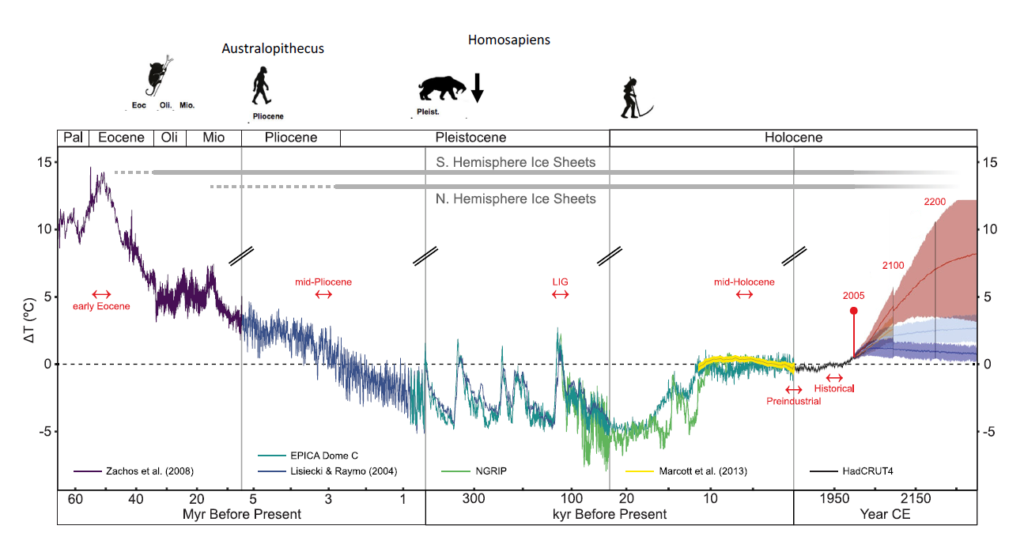
At the moment, we really aren’t doing much to reduce greenhouse gas emissions that are making temperatures rise very quickly. This suggests that if we want to know what conditions might be like in 2200, we have to look all the way back to what is known as the ‘palaeocene-eocene thermal maximum’ around 50 million years ago. This was a period long before homo-sapiens (our own species) existed. Life on Earth was very very different. There were no ice caps and many of the ecosystems we see today didn’t exist. If, however, we take urgent action to address climate change, the ‘nearest’ similar climate is the Last Interglacial period (LIG in the diagram) which was ‘only’ around 126,000 years ago.
Conditions and life forms at either of these times were not like those we see today. If we change the climate to this extent, we will see some land (like a lot of Pacific islands and low lying coastal areas) disappear under water, terrible devastation of coastal cities (including in Australia and Tasmania), and much human suffering. We will also lose many important ecosystems on which we rely for food. As thing becomes much more difficult we can expect increased conflict as people fight over diminishing resources. So, climate change has really significant implications. Not just for humans, but all species currently on the planet. The pace of change means that the ability to adapt is limited for most species.
This is an important question because it underlies what we know about the rate and level of current greenhouse gas emissions.
A lot of what we know comes from ice cores. Ice cores are excellent recorders of atmospheric gases like CO2. In the figure below (Figure 1) you can see measurements of CO2 based on gases collected from the atmosphere by specially made instruments(red and blue lines).These instruments have been used to monitor atmospheric concentrations since 1950 and the measurements align extremely well with what the ice cores from Antarctica are telling us. Therefore, we’re confident about what the ice cores say about CO2 concentrations hundreds, and thousands of years ago.
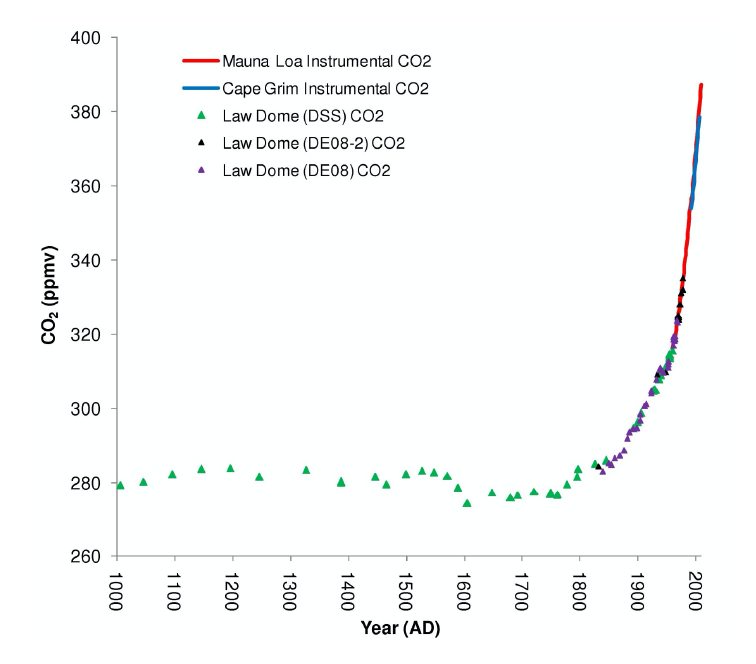
And how do we get CO2 concentration from ice cores? Ice has little bubbles of air in it.
These bubbles of air trapped in the ice core record what gases were in the atmosphere at
that time. As the next year’s snow falls, the older snow gets compacted, but the air bubbles
are still there. This process continues year after year, decade after decade, century after
century and so on.
Then an ice core scientist comes along and drills an ice core (long cylinder of ice) to collect
information about past climate from the ice. They use a lot of fancy machines to first work
out how old the ice is at points all the way down the core. They then extract the gases from
the air bubbles in the ice to work out what the gases are, and the quantities of different
gases along the core – from the youngest ice at the top all the way back to the oldest ice at
the bottom of the core. This provides a picture of how greenhouse gases have changed over
time.
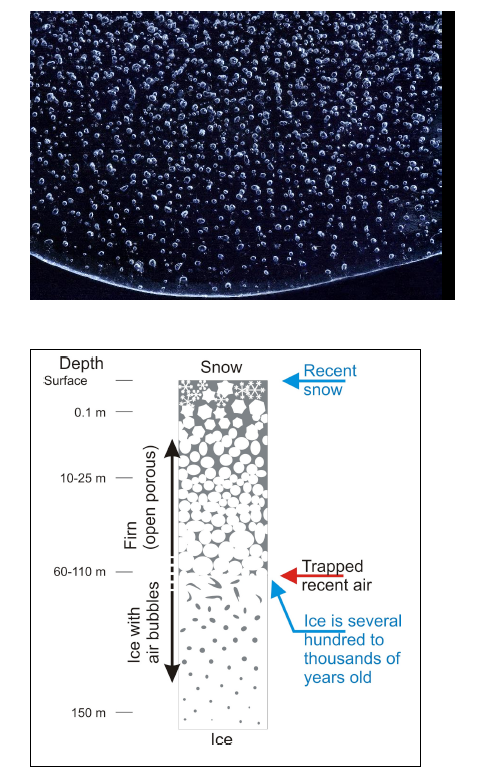
Figures supplied by Dr Tessa Vance, IMAS, UTas
Could the Earth ever enter another ice age? The short answer is quite probably, but maybe not for a very long time. However, nothing is certain, especially with the current human-induced changes now occurring. To explain why the answer is probably, we can look at what we know about past climate.
The Earth’s climate has varied over millions of years (see Figure 1). You can see that it was very warm around 56 millions years ago, and very cold around 25,000 years ago. The temperature has generally increased since about 20,000 years ago. But you can also see that there are a lot of ‘little’ ups and downs’. If you look at Figure 2, this shows variations over the last 800,000 years. The line in the middle is temperature. You can see that there are semi-regular periods of colder temperatures (glacial periods, or what some people call ice ages) that last for tens of thousands of years. The warmer (inter-glacials) and colder periods (glacials) can be related to a number of factors that affect Earth’s climate from ‘outside’ the Earth. We call these external forcings.
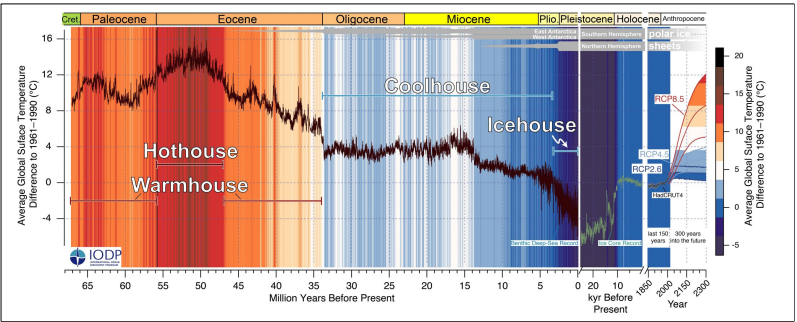
Source of Figure: Westerhold et al. 2020 Science
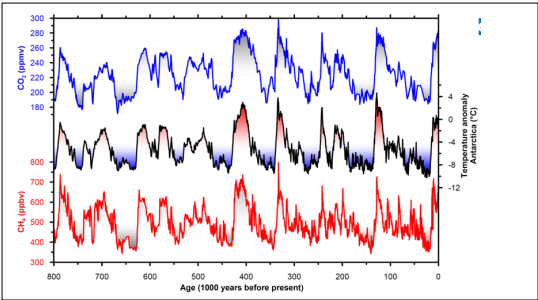
One of the important external forcings of glacial and interglacial periods is related to how earth travels around the sun. About 100 years ago, a smart guy from Serbia called Milutin Milankovic realised that there were three important ways the Earth’s orbit around the sun changed over long time periods. We can call these, stretch, wobble and roll (see Figure 3). These have periods (or cycles) of thousands of years. If you look at Figure 2 again, you can see that warm temperature periods occur around once every 100,000 years (give or take). This is very similar to the period of how Earth’s journey around the sun changes over time (stretch). So, around every 100,000 years, our orbit becomes more ‘circular’ or ‘less elliptical’, so we are closer to the sun. When our orbit becomes more elliptical, we are further away from the sun for much of the time, and our climate is cooler. The other two cycles are also important, but less relevant to your question. They will have important impacts on seasonal differences in the hemispheres and day lengths from the equator to the poles. In Figure 4, there’s a plot of the cycles over time, and down the bottom is a plot of stages of glacial and interglacial periods.
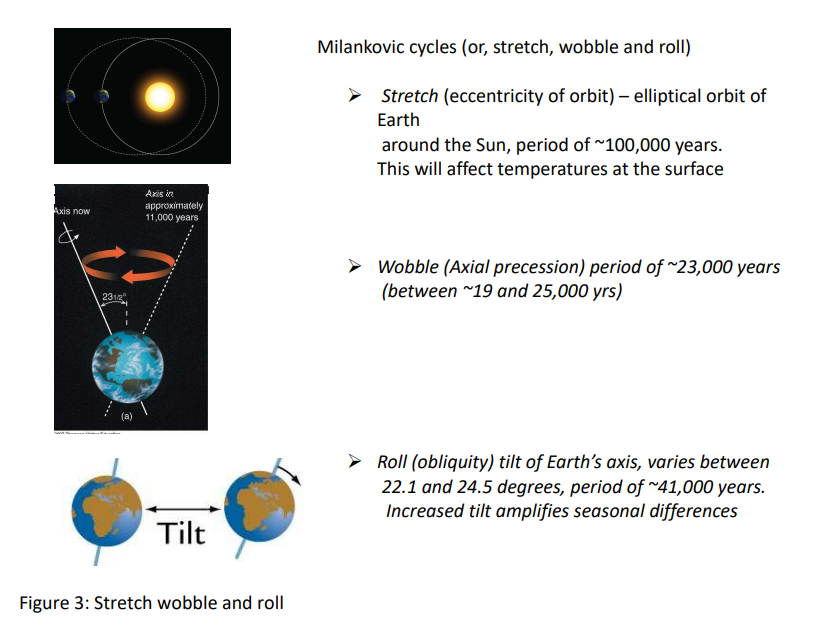
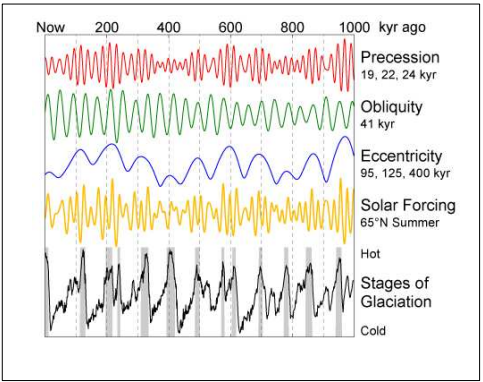
There are also other factors that affect the Earth’s climate that come from ‘outside’ the Earth (we can call these external forcings). You have probably heard of sunspots. There have been periods when there are less sunspots (the sun is cooler). When the sun is cooler, the Earth is cooler, too. These also have an impact on Earth’s climate, but on much shorter time scales (generally decades).
So, the longer answer to your question is that there are some factors that affect Earth’s climate that come from outside. These have big impacts on our climate and can ‘set up’ positive feedback loops meaning that when one thing happens it leads to another process which then causes some thing else. Like dominoes falling over. Or maybe like when you get up in the morning feeling a bit grumpy and say something not so nice to your brother or sister. They’re then nasty back to you and you get grumpier. When you go to school you’re still grumpy and take it out on your friends who then get grumpy with you. This would be positive feedback because one bad thing leads to another bad thing (or if you got up happy and said nice things…etc. That would also be positive feedback).
It is hard to know what will happen in the future with man-made climate change which is warming our planet very quickly. If we continue release CO2 as we are at present, we are unlikely to experience another ice age any time soon. Our orbit of the sun is currently quite ‘circular’ (or least elliptic) but is slowly becoming more eccentric. So, it is reasonably likely that some time in a little less than 100,000 years the Earth may enter another glacial period.
What it will look like then is another matter altogether.
Great question.
Yes, it will.
Records from the bottom of lakes or boggy places tell us that as past climate changed over thousands of years, the vegetation changed. Some places went from being grassland in colder periods to forests in warmer periods. In some cases, the type of forest changed. In Tasmania we can see changes from rainforest to eucalypt forest and vice versa at different times.
Thinking about how some climate changes in the past left footprints helps a bit. About 4,200 years ago there was a change in climate that resulted in many human populations dying out or moving elsewhere. Many others also changed the types of crops they planted or how they farmed animals, and what animals they farmed where. People who study these kinds of events have also found a lot of abandoned villages and towns. About 8-900 years ago in southwestern USA, drought caused some settlements to be abandoned, too. The most famous of these is Mesa Verde and the deserted city still exists.
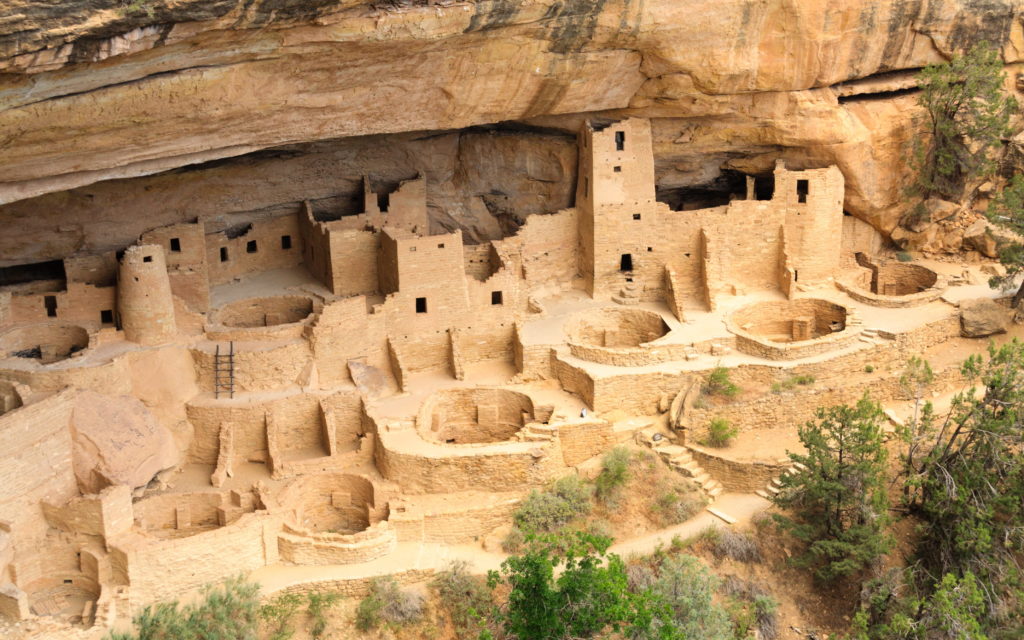
Right now, there are a lot of plants and animals that are finding it very hard to adapt to climate change because it’s happening so fast. It’s likely that at least some of these will die out (become extinct). Think about how Pencil pines on the Central Plateau behind Deloraine are doing. Quite a few have died from drought and many more died in fires in 1961 and more recently in 2016. As climate continues to change, we can expect more big hot fires that will kill these trees. Climate models also suggest that the west coast of Tasmania is likely to become drier. This will affect the Huon pine because it doesn’t like being dry. It likes having wet feet. These trees that can live for hundreds to thousands of years could disappear from Tasmania, and Tasmania is the only place they’re currently found.
As temperatures increase, we can also expect to get some of the pests that exist on the mainland. They haven’t been able to do well here before because it’s been too cold, but as it warms up, they will be much happier here. They might squeeze out (or maybe even feed on) other native species which will then have impacts on Tasmanian ecosystems for hundreds of years. If you were able to see what Tasmania looks like in 500 years, it will be very different to what it looks like now. Quite a few plant and animal species are likely to not exist while there may be species we don’t see here today.
So, climate change always leaves a footprint. We can find clues about this footprint in the environment.
This is a very good question. Our climate has changed since Earth was formed. These changes have resulted in radically different environments on Earth with very different plants and animals existing throughout the Earth’s history. During this time sea levels have fluctuated greatly also. One estimate of sea level rise over the past 40,000 years is about 105cm, or 1.05m.
Between 1920 and 2000, average sea level rise around Australia has been estimated as 1.2mm per year. The rate at which sea level is rising has increased since 1990, however.
The plot below shows how sea level has changed across the world. You can look at the website below the Figure to find out more information about sea level rise.

https://research.csiro.au/slrwavescoast/sea-level/
Climate models suggest that if humans undertake serious action to combat climate change, we can expect sea level to further increase by about between about 30 and 60cm by 2100. This increases to between 50 and 90cm if we continue living like we currently do.
The second image below shows how temperatures have changed over millions of years. You can also see some pictures of what animals may have been around at different times. Notice that human ancestors are only shown from around 4 million years ago.

https://link.springer.com/content/pdf/10.1007/s41748-019-00093-1.pdf
The rapid climate change we’ve seen over recent decades and that is due to human actions is happening so fast that many species can’t adapt to it and are becoming endangered or even extinct. For example, in Tasmania there are a lot of concerns about some of our unique plants and animals – like Huon pine or Pencil pine. Warming oceans also mean we are seeing more pests like the Pacific Sea Star or Crown-of-thorns starfish in Tasmanian waters that have impacts on native species.
Thank you for your question. I think there are two different parts to your question.
The first one may relate to weather rather than climate. Weather and climate are not the same thing. Weather is what happens from one day to the next, and yes, it certainly does change a lot, especially in Tasmania. Climate is the average weather over time.
Let’s talk about weather in Tasmania first. Our weather is affected by processes on a range of scales, and by other factors. One of these important factors in Tasmania is what we call topography – or land form. We have a lot of mountains in the west that rise up to Central Plateau and then in the east the land is generally flatter and lower elevation. Tasmania sits in a region known as the ‘Roaring Forties’ and most of our weather comes from the west
due to the way the atmosphere is ‘organised’. This means that when weather systems hit the west, they drop most of their rain in the west because the clouds carrying the rain have to rise up to get over the mountains. There’s often not much left by the time they get over the Central Plateau.
Another factor is that Tasmania is only a small island. You’ve probably seen weather maps like the one below. Low and high pressure systems pass over Tasmania. Air circulates clockwise around a low pressure system and anticlockwise around a high pressure system. Think about the low pressure system in the map that’s passing over southeastern Australia. If air circles clockwise around this system it means its picking up a lot of moisture from the Tasman sea which then gets dumped along eastern Australia, including Tasmania. As it moves further east – due to dominant westerly winds – we will start to get colder air from further south. If we had a high pressure system passing over Tasmania instead, we would first see winds from the south and then as it passed further to the east, the wind would come from the north. Winds from the north are warmer than winds from the south. Slightly
different locations (e.g. whether they are further south or further north) will also make a difference. So, our weather changes as one system passes over us and sometimes we can get four seasons in one day.
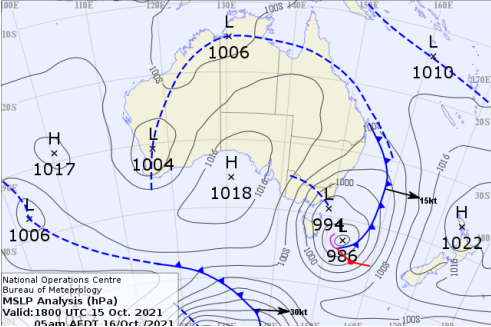
Now, in relation to a constantly changing climate. When we talk a about a changing climate, we’re talking about longer time scales. How long depends on your perspective. For example, people who work with just data that has been measured over the past century would look at trends and change over the past century. Others who study what we can find out about climate from things like sediment, ice cores, tree-rings or corals will look at how climate has changed over hundreds or thousands of years. Some people will look at changes in rainfall and others might look at changes in temperature over land or temperature of the sea.
Just a few things that affect climate over different time scales are:
- Changes in what we call ‘modes of variation’ like El Niño-Southern Oscillation which affects rainfall in eastern Australia in particular (there are other modes of variation, but you’ve probably heard about El Niño – the others are not so often spoken about). El Niño for example has a ‘sort-of’ cycle of about 7 years.
- Human-induced changes like greenhouse gas emissions. Very important factor over the past ~200 years
- Things like sunspots that affect how hot the sun is. Less sunspots mean a cooler sun that then affects how warm Earth is. These can affect Earth’s climate for several decades at a time.
- REALLY long-term changes like how the Earth orbits the sun. This can affect climate at periods of hundreds of thousands of years.
- Big volcanic eruptions – these might affect climate for a few years at a time. But if several big ones occur close together (and depending where they are), the effects might last a decade or more.









